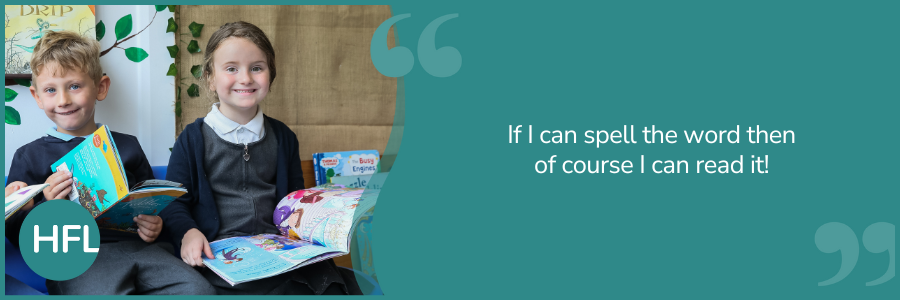
Can you believe the first Phonics Screening Check was administered to Year One children in 2012? Those pupils are now around 18 years old. I wonder how those who didn’t meet the threshold that first year are now doing…? We are all a little older, wiser and perhaps greyer. But what have we learnt about:
- what comes up most frequently in phonics checks?
- what do we prioritise for teaching the next cohort of year one children?
- what reliable information does this snapshot test give us?
- how can we best close gaps for any children who have not yet met the minimum threshold in the check?
- what’s the best, most inclusive, form of acceleration for preventing gaps, especially for disadvantaged and vulnerable children (including those with SEND)?
Those are indeed some thought-provoking questions, but ones we know we all need to probe. The link has sadly been proven time and time again between economically disadvantaged and vulnerable groups and lack of fluent word-level skills, ie accurate and speedy recall of the grapheme-phoneme correspondences, exception word knowledge and blending to automaticity… and especially so in terms of taking their spelling to fluency when writing. It does seem to be an almost accepted truth – if you are economically disadvantaged and/or vulnerable, or have SEND, then you are bound to struggle with spelling. And yes, English spelling has many, shall we say, foibles…historical footprints, if you will. But…our ‘hardest-to-reach’ children desperately need us to focus our attentions on areas of curriculum that are the hardest-to-teach. If we focus first on the hard parts, with our freshest energies and sharpest thinking, the rest tends to fall into place. So, the same can be said for spelling (encoding) and reading (decoding). Research (see reference list below) shows that the greatest impact on both word reading and spelling comes from a sharp focus on spelling. In the words of a 7-year-old boy attracting PPG I met a few years ago, when I asked why he was practising some spelling during reading time:
“If I can spell the word then of course I can read it!”
I was firmly put back in my box.
And blown away.
So, here are my thoughts and yes, a few dips into some of those hard-to-teach areas and hard-to-ask questions.
What does the Year One Phonics Screening Check tell us about children who have scored 32 (minimum pass-mark)?
They may only be secure with Year 1 Term 1 learning (as measured against majority of the DfE Validated Phonics Schemes). It’s completely possible to pick up 32 marks with only Y1T1 learning secured, and remember this is not even a test of fluency, application amongst increased cognitive load such as reading a book, exception word-reading or even spelling. This is purely a health check of (a) can this child retain a core of survivability GPCs and (b) can they, in their own time – and possibly via heavy self-scaffolding such as sound-buttoning – blend the sounds together accurately. It’s effectively looking to see whether a child has learnt a Reception year’s worth of phonics over TWO YEARS.
Did children need to be secure with split vowel digraphs to pass?
No. It was entirely possible to pick up 32 marks without them. This should ideally form the first block of teaching in Year 2, through the multisensory medium of spelling, to ensure no one is left behind. Split vowel digraphs are notoriously tricky for many children with difficulties in literacy, as are the following items in the table. The most reliable and memorable way to teach these for reading is to do so through teaching of spelling. Manipulation of concrete resources and graphemes (Sermier, 2021, as cited in DfE’s Reading Framework 2023, pp77, re children with ‘intellectual disability’; Labat et al., 2015; Lemons et al., 2018), writing by hand that helps light up the reading bits of the brain (Van der Weel, 2024; Ihara, 2021; Askvik, 2020) and a healthy dollop of self-regulation and metacognition (EEF) in the form of proofreading and self-correcting, all help create the sturdiest possible orthographic representations in the memory. This has now been shown, in just the past few years, to also be true of those with autism and Down syndrome, which indicates how rapidly the research in this area is evolving.
What other challenges may have tripped up the children who struggled most?
Words that look visually similar to another known word (key to notation below: what the child might offer / what the target word actually was > followed by examples of next steps):
- nob/nop; blink/blenk; scrub/scrup > possibly a speech and language issue; use mirrors together with multisensory approach to GPC revision; use a sound phone that amplifies own enunciation into own ear (cf ‘explicit instruction’, EEF’s SEND 5-a-day)
- my/yim; lid/ild; isn’t/sint; spilt/split > needs support with consistent left-to-right eye tracking; overlearning, making eyes, finger and voice all match at same time (eg ‘stroke the word’)
- shed/sheb; drop/brop; dew/bew > deal with b/d separately! Don’t teach confusable words / GPCs together – teach for difference. Overlearn and become truly fluent with one confusable, get it really automatic and sturdy in the memory, then brain is able to rule an option out and narrow down possibilities. Get one ‘really there’, then deal with the ‘nearly there’.
Were there any shifts in trends of test design in 2024?
- Rise in occurrence of ‘ball and stick’ letters (ie b, d, p, q) – security in these has a correlation with mileage of ‘just right’, or fluency level, text reading. This could be a way of checking for this. Or just a shift towards checking that prior learning is very much secure.
- Slight increase in consonant digraphs. Tiny shifts each year, but worth bearing in mind.
- BIG drop in occurrence of vowel digraphs, from 18 to 20 to 13 this year. This suggests a real shift back towards checking on children’s prior learning. This could also be supported by the most commonly occurring target item being ‘ball and stick’ letters and adjacent consonants, and until this year also vowel digraphs.
| How many words in each year’s check contained these target items? | 2022 | 2023 | 2024 | Change seen? |
| ‘ball & stick’ letters | 18 | 19 | 23 |  |
| consonant digraphs | 10 | 11 | 12 |  |
| adjacent consonants | 23 | 21 | 22 |  |
| …of which contain 2 adjacent consonants (beginning) | 11 | 10 | 11 |  |
| …of which contain 2 adjacent consonants (ending) | 9 | 10 | 9 |  |
| …of which contain adjacent consonants (both beginning AND ending) | 4 | 4 | 4 |  |
| …of which contain 3 adjacent consonants | 4 | 4 | 4 |  |
| vowel digraphs | 18 | 20 | 13 |  |
| …of which are ‘r’ controlled | 4 | 7 | 5 |  |
| …of which are ‘w’ controlled | 2 | 1 | 1 |  |
| …of which are ‘y’ controlled | 0 | 1 | 1 |  |
| vowel trigraphs | 1 | 0 | 0 |  |
| split vowel digraphs | 6 | 5 | 5 |  |
Use this analysis tool for diagnostic assessment to identify children’s gaps in learning and next steps.
For more guidance on acting on this year’s check results PLUS the whole back-catalogue of analysis grids for all past PSC papers, book onto our e-learning:
References
Blogs:
A Tale of Two Biggies: the two A’s of Phonics (Assessment & Application)
Podcast:
‘Fight'n Words? The Dyslexia Debate Revisited’ in conversation with Julian Elliott
https://pod.link/1629058475/episode/6a94fa813f6eca3570286b53f5d75b59
Articles cited:
Labat, H., Vallet, G., Magnan, A. and Écalle, J. (2015). Facilitating effect of multisensory letter encoding on reading and spelling in 5-year-old children. Applied Cognitive Psychology, 29 (2015), pp381–39. doi: 10.1002/acp.3116
Lemons, C., Allor, J., Al Otaiba, S. and LeJeune, L. (2018). 10 Research-based tips for enhancing literacy instruction for students with intellectual disability. Teaching Exceptional Children, 50 (4) (2018), pp. 220-232. doi: 10.1177/0040059918758162
Sermier Dessemontet, R., de Chambrier, A.-F., Martinet, C., Meuli, N., and Linder, A.-L. (2021). Effects of a phonics-based intervention on the reading skills of students with intellectual disability. Research in Developmental Disabilities, 111, 103883. https://doi.org/10.1016/j.ridd.2021.103883
Van der Weel, F. and Van der Meer, A. (2024). Handwriting but not typewriting leads to widespread brain connectivity: a high-density EEG study with implications for the classroom. Frontiers in Psychology. 14:1219945. https://doi.org/10.3389/fpsyg.2023.1219945
Ihara, A., Nakajima, K., Kake, A., Ishimaru, K., Osugi, K. and Naruse, Y. (2021). Advantage of Handwriting Over Typing on Learning Words: Evidence From an N400 Event-Related Potential Index. Frontiers in Human Neuroscience. 15:679191. doi: 10.3389/fnhum.2021.679191
Ose Askvik, E., van der Weel, F. and van der Meer, A. (2020). The Importance of Cursive Handwriting Over Typewriting for Learning in the Classroom: A High-Density EEG Study of 12-Year-Old Children and Young Adults. Frontiers in Psychology. 11:1810. doi: 10.3389/fpsyg.2020.01810



